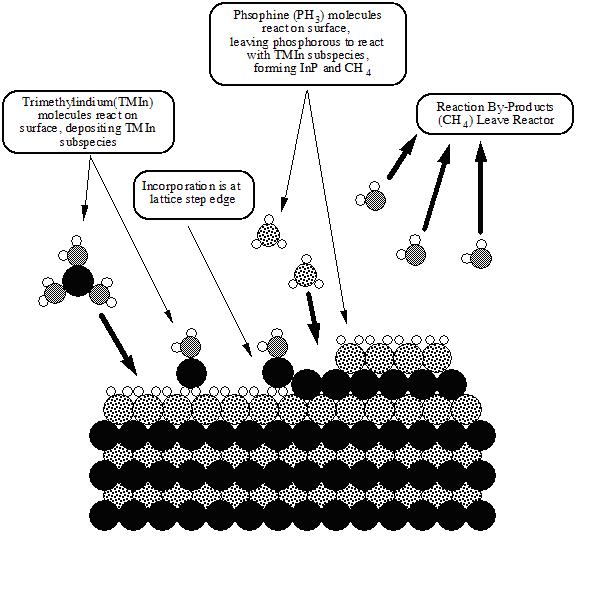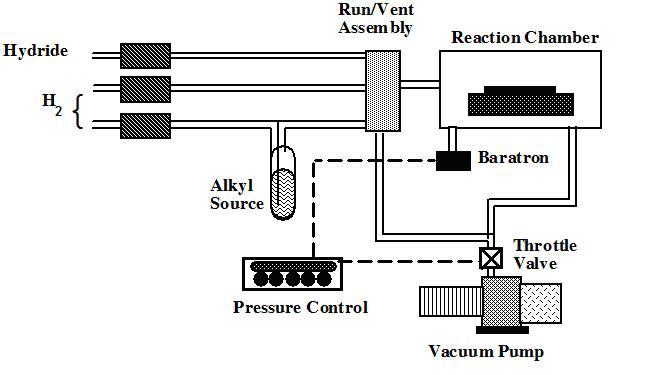Metalorganic vapour phase epitaxy (MOVPE), also known as organometallicvapour phase epitaxy (OMVPE) or metalorganic chemical vapour deposition (MOCVD), is an arranged chemical vapour deposition method. It is a highly complex process for growing crystalline layers to create complex semiconductor multilayer structures. In contrast to molecular beam epitaxy (MBE) the growth of crystals is by chemical reaction and not physical deposition. This takes place not in a vacuum, but from the gas phase at moderate pressures (2 to 100 kPa). As such, this technique is preferred for the formation of devices incorporating thermodynamically metastable alloys, and it has become a major process in the manufacture of optoelectronics.
Basic principles of the MOVPE process
In MOVPE ultra pure gases are injected into a reactor and finely dosed to deposit a very thin layer of atoms onto a semiconductor wafer. Surface reaction oforganic compounds or metalorganics and hydrides containing the required chemical elements creates conditions for crystalline growth - epitaxy of materials andcompound semiconductors. Unlike traditional silicon semiconductors, these semiconductors may contain combinations of Group III and Group V, Group II andGroup VI, Group IV, or Group IV, V and VI elements.

For example, indium phosphide could be grown in a reactor on a heated substrate by introducing trimethylindium ((CH3)3In) and phosphine (PH3) in a first step. The heated organic precursor molecules decompose in the absence of oxygen - pyrolysis. Pyrolysis leaves the atoms on the substrate surface in the second step. The atoms bond to the substrate surface and a new crystalline layer is grown in the last step. Formation of this epitaxial layer occurs at the substrate surface.
Required pyrolysis temperature increases with increasing chemical bondstrength of the precursor. The more carbon atoms are attached to the central metal atom the weaker the bond. The diffusion of atoms on the substrate surface is affected by atomic steps on the surface. Atoms move preferentially from high to low steps.
The vapor pressure of the metal organic source is an important consideration in MOVPE, since it determines the concentration of the source material in the reaction and the deposition rate.
MOVPE reactor components
In the vapor phase epitaxy (VPE) technique, reactant gases are combined at elevated temperatures in the reactor to cause a chemical interaction, resulting in the deposit of materials on the substrate.

- A reactor is a chamber made of a material that does not react with the chemicals being used. It must also withstand high temperatures. This chamber is composed by reactor walls, liner, a susceptor, gas injection units, and temperature control units. Usually, the reactor walls are made from stainless steel or quartz. Ceramic or special glasses, such as quartz, are often used as the liner in the reactor chamber between the reactor wall and the susceptor. To prevent overheating, cooling water must be flowing through the channels within the reactor walls. A substrate sits on a susceptor which is at a controlled temperature. The susceptor is made from a material resistant to the metalorganic compounds used; graphite is sometimes used. For growing nitrides and related materials, a special coating on the graphite susceptor is necessary to prevent corrosion by ammonia (NH3) gas.
- One type of reactor used to carry out MOCVD is a cold-wall reactor. In a cold-wall reactor, the substrate is supported by a pedestal, which also acts as a susceptor. The pedestal/susceptor is the primary origin of heat energy in the reaction chamber. Only the susceptor is heated, so gases do not react before they reach the hot wafer surface. The pedestal/susceptor is made of a radiation-absorbing material such as carbon. In contrast, the walls of the reaction chamber in a cold-wall reactor are typically made of quartz which is largely transparent to the electromagnetic radiation. The reaction chamber walls in a cold-wall reactor, however, may be indirectly heated by heat radiating from the hot pedestal/susceptor, but will remain cooler than the pedestal/susceptor and the substrate the pedestal/susceptor supports.
- In hot-wall CVD, the entire chamber is heated. This may be necessary for some gases to be pre-cracked before reaching the wafer surface to allow them to stick to the wafer.
- Gas inlet and switching system. Gas is introduced via devices known as 'bubblers'. In a bubbler a carrier gas (usually nitrogen or hydrogen) is bubbled through the metalorganic liquid, which picks up some metalorganic vapour and transports it to the reactor. The amount of metalorganic vapour transported depends on the rate of carrier gas flow and the bubbler temperature, and is usually controlled automatically and most accurately by using a Piezocon type vapour control system. Allowance must be made for saturated vapors.
- Pressure maintenance system
- Gas exhaust and cleaning system. Toxic waste products must be converted to liquid or solid wastes for recycling (preferably) or disposal. Ideally processes will be designed to minimize the production of waste products.





